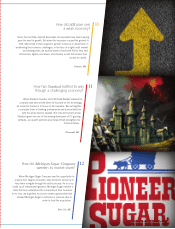Comerica 2010 Annual Report Download - page 17
Download and view the complete annual report
Please find page 17 of the 2010 Comerica annual report below. You can navigate through the pages in the report by either clicking on the pages listed below, or by using the keyword search tool below to find specific information within the annual report.• Doubled the quarterly dividend to 10 cents per share in the fourth quarter following the overall positive
financial performance trends of the Corporation and a modest improvement in the economy. In addition, the
Corporation’s Board of Directors authorized the repurchase of up to 12.6 million shares of common stock in
the open market and also authorized the purchase of outstanding warrants to purchase up to 11.5 million
shares of the Corporation’s common stock.
• Redeemed $515 million of 6.576% subordinated notes due 2037 at par in the fourth quarter 2010. The notes
related to $500 million of trust preferred securities issued by an unconsolidated subsidiary, which were
concurrently redeemed. The Corporation additionally early redeemed $2 billion of Federal Home Loan Bank
(FHLB) advances without penalty in 2010.
• Continued to aggressively focus resources on managing credit quality in 2010, particularly in the
Commercial Real Estate business line. Within the Commercial Real Estate business line, year-end 2010
residential real estate development exposure was reduced by $507 million, or 48 percent, compared to
year-end 2009, and by $1.4 billion, or 71 percent, compared to year-end 2008.
• Maintained strong capital ratios, while eliminating all preferred stock and trust preferred securities from Tier
1 and total capital. Tier 1 common capital was 10.13 percent at December 31, 2010, up from 8.18 percent at
December 31, 2009.
• Increased loan and deposit spreads as a result of a strategic initiative which commenced in mid-2008 to better
align risk with appropriate returns in changing market conditions.
• On January 18, 2011, announced a definitive agreement to acquire Sterling Bancshares, Inc. (Sterling) under
which the Corporation will acquire all of the outstanding shares of Sterling common stock in a
stock-for-stock transaction. Under the terms of the agreement, each outstanding share of Sterling common
stock will be exchanged for 0.2365 shares of the Corporation’s common stock upon closing. The transaction
is expected to be completed by mid-year 2011 and is subject to customary closing conditions, including
approval by Sterling shareholders and regulatory approvals. Sterling is a Houston-based bank holding
company with total assets of $5.2 billion at December 31, 2010, which operates banking centers in Houston,
San Antonio, Fort Worth and Dallas, Texas.
OVERVIEW
Comerica Incorporated (the Corporation) is a financial holding company headquartered in Dallas, Texas.
The Corporation’s major business segments are the Business Bank, the Retail Bank and Wealth & Institutional
Management. The core businesses are tailored to each of the Corporation’s four primary geographic markets:
Midwest, Western, Texas and Florida.
The accounting and reporting policies of the Corporation and its subsidiaries conform to U.S. generally
accepted accounting principles (GAAP). The Corporation’s consolidated financial statements are prepared based
on the application of accounting policies, the most significant of which are described in Note 1 to the
consolidated financial statements. The most critical of these significant accounting policies are discussed in the
“Critical Accounting Policies” section of this financial review.
As a financial institution, the Corporation’s principal activity is lending to and accepting deposits from
businesses and individuals. The primary source of revenue is net interest income, which is principally derived
from the difference between interest earned on loans and investment securities and interest paid on deposits and
other funding sources. The Corporation also provides other products and services that meet the financial needs of
customers and which generate noninterest income, the Corporation’s secondary source of revenue. Growth in
loans, deposits and noninterest income is affected by many factors, including economic conditions in the markets
the Corporation serves, the financial requirements and economic health of customers, and successfully adding
new customers and/or increasing the number of products used by current customers. Success in providing
products and services depends on the financial needs of customers and the types of products desired.
15
























